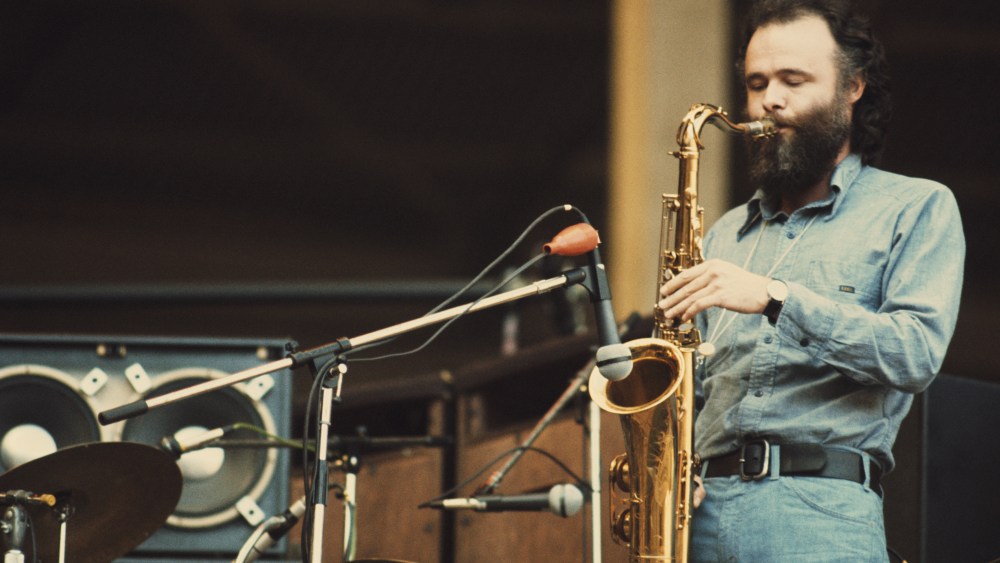Garth Hudsonwhose amazing approach to the organ and virtuosity on a variety of other instruments gave a distinctive touch to the roots rock of the Canadian-American group the bandhas died, according to Toronto star. Hudson “passed away peacefully in his sleep” Tuesday morning at a nursing home in the band’s longtime home base of Woodstock, New York, the musician’s executor confirmed to the publication. He was 87.
Retired and rarely interviewed, Hudson was the quiet man in the group that began life as the Hawks, Arkansas-born rockabilly singer Ronnie Hawkins’ backup band, which in 1966 graduated to supporting Bob Dylan on his tumultuous first tour as a rock ‘n’ roll artist .
After chopping wood with Dylan in West Saugerties, NY – where Hudson served as a recording engineer for Dylan and the group’s legendary “basement band” – the musicians stepped out as the band on a stunning 1968 debut, “Music From Big Pink”. That album and the self-titled follow-up from 1969 established them as one of the best rock acts of the day.
In a typically self-effacing, and usually rare, interview with Canadian magazine Maclean’s in 2003, Hudson—the only band member who never contributed vocally on stage or record—minimized his unique achievements.
“It was a job,” he said. “Play a stadium, play a theater. My job was to arrange notes under, notes and fills behind good poets. The same poems every night.”
Robbie Robertson, the band’s guitarist and songwriter during the group’s years of stardom (as himself passed away in August 2023), offered a much more effusive assessment of what Hudson brought to the table in his 2016 memoir Testimony
“He played brilliantly, in a more complicated way than anyone we had ever tussled with,” he wrote. “Most of us had just picked up our instruments as kids and plowed ahead, but Garth was classically trained and could find musical avenues on the keyboard that we didn’t know existed. It impressed us deeply.”
He made an unforgettable statement with a long, Bach-inspired introduction — later a stand-alone concert feature known as “The Genetic Method” — to “Chest Fever,” a cryptic “Big Pink” rocker.
Each album contained a song that demonstrated Hudson’s prodigious gifts: “Up On Cripple Creek,” with its jangly, wah-wah-infused clavinet, on “The Band”; “Daniel and the Sacred Harp”, with an elegant church organ intro, on “Stage Fright” (1970); the Dylan cover “When I Paint My Masterpiece”, highlighted by his accordion obbligato, on “Cahoots” (1971); the brooding “Third Man Theme,” the old Hawks break song, from the covers collection “Moondog Matinee” (1973); and “It Makes No Difference”, a lush ballad with Hudson’s soprano saxophone work, from “Northern Lights-Southern Cross” (1975).
After the band’s acclaimed star-studded farewell show, “The Last Waltz”, in San Francisco on Thanksgiving 1976, the act closed in the studio with “Islands” (1977); the title instrumental turned out to be Hudson’s sole co-writing credit.
After a failed attempt at a reunion, a lot of very public bickering between Robertson and the other members of the band—notably drummer Levon Helm, who had served as the Hawks’ first musical director—and pianist and singer Richard’s suicide in 1986, Manuel regrouped in 1993 for the album “Jericho”, with Jim Weider replacing the guitarist. Two more albums followed in 1996 and 1998, but the group was unable to regain the commercial influence of their glory years.
Hudson, who regularly performed the band’s music on tour in later years, released three solo albums on independent labels. In 2010, he curated “A Canadian Celebration of the Band,” a salute to the group featuring compatriots Neil Young, Bruce Cockburn, Mary Margaret O’Hara, Cowboy Junkies and Blue Rodeo.
He was inducted into the Rock and Roll Hall of Fame as a member of the band in 1994 and received a Lifetime Achievement Award from the Recording Academy in 2008. The group became part of the Juno Awards Canadian Music Hall of Fame in 1989.
He was born Eric Garth Hudson in Windsor, Ontario on August 2, 1937 and grew up in the northeast city of London. His family was musical: his father played the flute, drums, cornet and saxophone and performed in local dance bands, and his mother played the accordion. He grew up listening to country and jazz. His first public experience of music was playing hymns in an uncle’s funeral home.
In Helm’s 1993 memoir This Wheel’s On Fire, he recalled, “my parents sent me to study piano at the Toronto Conservatory. I had a good teacher who used older methods and older pieces. That’s how I learned to play Bach’s preludes and fugues, that kind of stuff. I loved Chopin, and Mozart surprised me. But I found I had trouble memorizing classical music … so I developed my own method of ear training and realized I could improvise.”
After a year studying music at the University of Western Ontario in London, he dropped out and started playing professionally. In the late 50s he worked with the regional bands Silhouettes and Paul London and the Kapers. His abilities caught the attention of Helm, who lobbied Hawkins to bring him into the Hawks.
“Garth was different,” Hawkins told Barney Hoskyns in “Across the Great Divide,” his 1993 book about the band. “He was hearing all sorts of weird noises in his head, and he was playing the Phantom of the Opera. He wasn’t a rock ‘n’ roll person at all, but it was fitting.”
Hudson — who was paid an additional $10 a week to teach his bandmates music, to appease his dodgy parents — became the oldest member of a lineup that included Helm, Robertson, Manuel and bassist Rick Danko. As part of his deal, he was eventually rewarded with a new Lowrey electronic organ; Hudson found it more versatile and easier to manipulate than the popular Hammond B-3. A gearhead and tinkerer by nature, he adapted the instrument (perhaps most importantly with a pitch shifter), and it became the capstone of his sound.
After splitting in 1963 with Hawkins, whom they came to see as a frugal disciplinarian, the group recorded singles such as Canadian Squires and Levon & the Hawks. Hudson, Helm and Robertson backed blues singer John Hammond, Jr. (son of Columbia Records A&R legend) on his album “So Many Roads”. A recommendation from Mary Martin, assistant to Bob Dylan’s manager Albert Grossman, led to a job as Dylan’s band on his 1965-66 world tour.
Depressed by the violent reaction of Dylan’s folk fans to his new electric music, Helm left the group early in the tour and was replaced by Trini Lopez drummer Mickey Jones. The Hawks soldiered through a troubled series of dates in the US and Europe. They parted ways at the end of the tour, but Dylan, recovering from a serious motorcycle accident, called Hawks to the woodshed with him in West Saugerties, NY
They recorded a wide range of old American music and new Dylan compositions in his home and in the basement of a pink ranch house, “Big Pink”, where most of the musicians lived together; Hudson rolled the tapes at Dylan’s direction. As label interest in the Hawks developed, Helm returned to the unit and participated in some of the basement sessions. Several of the so-called “basement tapes” were eventually tapped by Hudson to be used as music publishing demos; these songs eventually made a bootleg appearance on the first major rock bootleg album, the 1969 two-LP set “The Great White Wonder”.
Signed to Capitol Records in their own right, the Hawks adopted a new handle, the band. The group recorded for the label for a decade, releasing seven studio albums and a highly acclaimed two-LP live set, “Rock of Ages.” They also supported Dylan on the collaborative Asylum Records set “Planet Waves” (1974), which reached No. 1 in the US, and a joint headlining tour that year, which led to the concert set “Before the Flood”.
At Capitol and on the band’s three reunion albums, Hudson distinguished himself as a do-anything player; his instrumental arsenal included tenor, baritone and soprano saxophones, piccolo, accordion, synthesizer, clavinet, slide trumpet and the occasional piano.
A frequent collaborator with Hal Willner, he played at the producer’s Harry Smith Project concert at UCLA’s Royce Hall in 2001; the five-hour show ended with a recessional organ solo by Hudson. In 2016-17, Hudson appeared regularly as a member of the “Last Waltz 40 Tour”, an all-star touring tribute to the ’76 concert. He was a special guest at the Wild Honey Orchestra’s 2017 autism research benefit at Glendale’s Alex Theatre, which featured full-length performances of “Music From Big Pink” and “The Band.”
Maud Hudson, his wife of 43 years and longtime musical partner, died in February 2022.





